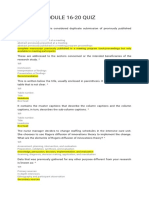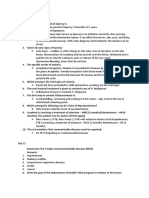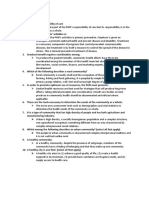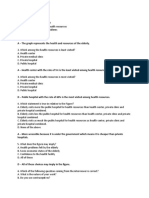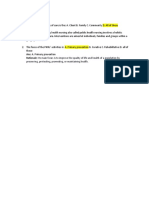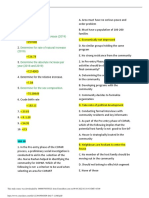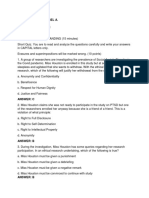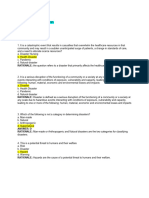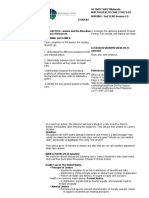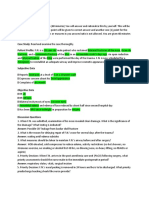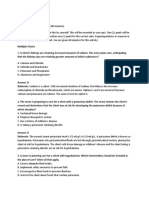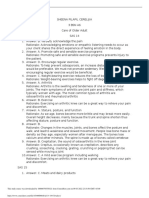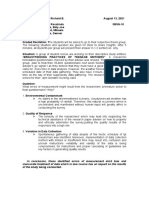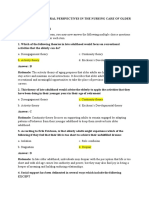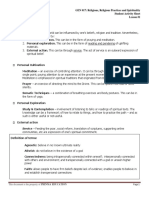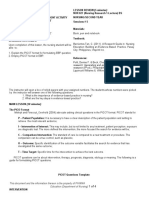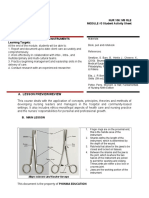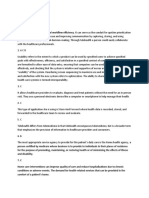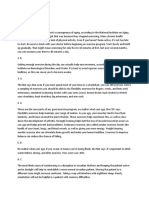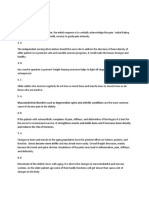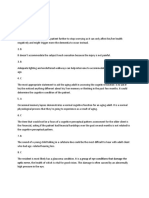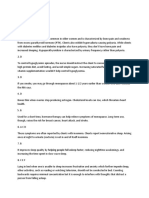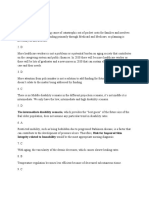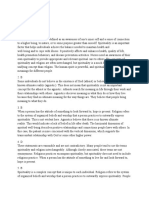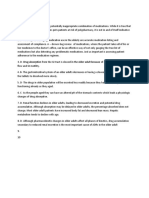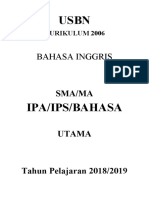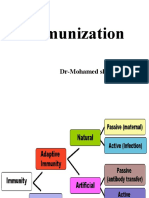SAS 22
CHECK FOR UNDERSTANDING (60 minutes)
You will answer and rationalize this by yourself. This will be recorded as your quiz. One (1) point will be
given to correct answer and another one (1) point for the correct ratio. Superimpositions or erasures in
you answer/ratio is not allowed. You are given 60 minutes for this activity:
Multiple Choice
1. Lassa and Ebola are emergent viruses in W. Africa. What is their origin?
a. Humans
b. Primates
c. Fruit bats
d. Pigs
Answer: C
Rationale: Bats are a very important and widespread mammalian species and a source of many
emergent viruses especially where they are used for food. Cooking fortunately destroys these viruses.
2. How can the morphology of filoviruses be described?
a. Very large ball like structure
b. Long filamentous threads
c. Icosahedral virion
d. Floppy membranes without defined morphology
Answer: B
Rationale: Viruses of the family can be 1400nm in length and once seen under the EM are never
forgotten!
3. How can the spread of filoviruses be restricted?
a. New antivirals
b. New humanized monoclonal antibodies
c. Hygiene and social distancing
d. New vaccine
Answer: C
Rationale: There are no monoclones, vaccines or antivirals of proven efficacy. Hand hygiene with hot
water and soap will easily destroy these elongate lipid viruses and keeping a distance from infected
persons (quarantine) and from funerals (Ebola in W. Africa) are vital behaviours.
�4. What is the biggest risk factor for infection with Ebola?
a. Working in a category IV laboratory
b. Attending a funeral of a victim outside
c. Nursing a patient at home
d. Attending football matches or large gatherings
Answer: C
Rationale: The answer here is mostly correct viz close medical care of a patient without personal
protective equipment (PPE) and a high standard of hygiene. The virus will not spread by droplets at a
match for example.
5. In which order will the nurse perform the following actions as she prepares to leave the room of a
client with airborne precautions after performing oral suctioning?
1. Take off goggles
2. Take off gown
3. Remove gloves
4. Remove N95 respirator
5. Perform hand hygiene
a. 1, 2, 3, 4, 5
b. 2, 1, 4, 3, 5
c. 3, 4, 1, 2, 5
d. 4, 3, 2, 1, 5
Answer: B
Rationale: This sequence will prevent contact of the contaminated gloves and gown with areas (such as
your hair) that cannot be easily cleaned after client contact and stop transmission of microorganisms to
you and your other clients. The correct method for donning and removal of personal protective
equipment (PPE) has been standardized by agencies such as the CDC and the Occupational Safety and
Health Administration. Focus: Prioritization
6. The nurse assessed the client and noted shortness of breath and recent trip to China. The client is
strongly suspected of having Middle East Respiratory Syndrome (MERS-CoV). Which of these
prescribed actions will the nurse take first?
a. Place the client on airborne and contact precautions
b. Introduce normal saline at 75 mL/hr
c. Give methylprednisolone (SOLU-Medrol) 1 g intravenously (IV)
d. Take blood, urine, sputum cultures
Answer: A
Rationale: MERS-CoV is considered deadly so the initial action is to protect other clients and healthcare
workers by securing the client in isolation. If an airborne-agent isolation (negative-pressure) room is not
yet available, droplet precautions should be initiated until the client can be moved to a negative-
�pressure room. B, C, and D: The other actions should also be taken immediately but are not as
important as preventing transmission of the disease.
7. The school nurse is asked which action will take to have the most impact on the incidence of
infectious diseases in school. The correct response is:
a. Grant written information about infection control to all parents
b. Ensure that students are immunized according to national guidelines
c. Make soap and water easily accessible in the classrooms
d. Educate students on how to cover their mouths when coughing
Answer: B
Rationale: The incidence of once-common infectious diseases like measles, chickenpox, and mumps has
been most effectively reduced by immunization of all school-aged children. Options A, C, and D: The
other options are also important but will not have much impact as immunization.
8. A 10-year-old client contracted SARS when traveling abroad with her parents. The nurse knows she
must put on personal protective equipment to protect herself while providing care. Based on the
mode of SARS transmission, which personal protective should the nurse wear?
a. Gloves
b. Gown and gloves
c. Gown, gloves, and mask
d. Gown, gloves, mask, and eye goggles or eye shield
Answer: D
Rationale: The transmission of SARS isn’t fully understood. Therefore, all modes of transmission must be
considered possible, including airborne, droplet, and direct contact with the virus. For protection from
contracting SARS, any health care worker providing care for a client with SARS should wear a gown,
gloves, mask, and eye goggles or an eye shield.
9. A client who has recently traveled to Hong Kong comes to the emergency department (ED) with
increasing shortness of breath and is strongly suspected of having a SARS. Which of these prescribed
actions will you take first?
a. Place the client on contact and airborne precautions
b. Obtain blood, urine, and sputum for cultures
c. Administer methylprednisolone (Solu-Medrol) 1 gram/IV
d. Infuse normal saline at 100ml/hr
Answer: A
Rationale: SARS is considered deadly so the initial action is to protect other clients and healthcare
workers by securing the client in isolation. If an airborne-agent isolation (negative-pressure) room is not
yet available, droplet precautions should be initiated until the client can be moved to a negative-
�pressure room. B, C, and D: The other actions should also be taken immediately but are not as
important as preventing transmission of the disease.
10. The school nurse is asked which action will take to have the most impact on the incidence of
infectious diseases in school. The correct response is:
a. Grant written information about infection control to all parents
b. Ensure that students are immunized according to national guidelines
c. Make soap and water easily accessible in the classrooms
d. Educate students on how to cover their mouths when coughing
Answer: B
Rationale: The incidence of once-common infectious diseases like measles, chickenpox, and mumps has
been most effectively reduced by immunization of all school-aged children. Options A, C, and D: The
other options are also important but will not have much impact as immunization.

